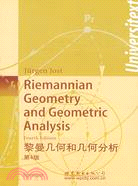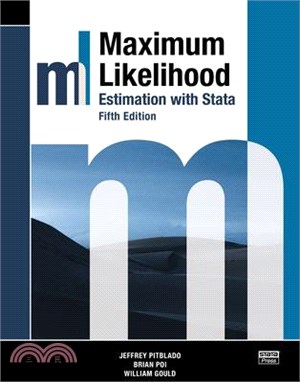商品簡介
目次
商品簡介
Riemannian geometry is characterized, and research is oriented towards and shaped by concepts (geodesics, connections, curvature, ...) and objectives, in particular to understand certain classes of (compact) Riemannian manifolds defined by curvature conditions (constant or positive or negative curvature, ...). By way of contrast, geometric analysis is a perhaps somewhat less systematic collection of techniques, for solving extremal problems naturally arising in geometry and for investigating and characterizing their solutions. It turns out that the two fields complement each other very well; geometric analysis offers tools for solving difficult problems in geometry, and Riemannian geometry stimulates progress in geometric analysis by setting ambitious goals.
It is the aim of this book to be a systematic and comprehensive introduction to Riemannian geometry and a representative introduction to the methods of geometric analysis. It attempts a synthesis of geometric and analytic methods in the study of Riemannian manifolds.
It is the aim of this book to be a systematic and comprehensive introduction to Riemannian geometry and a representative introduction to the methods of geometric analysis. It attempts a synthesis of geometric and analytic methods in the study of Riemannian manifolds.
目次
1. Foundational Material
1.1 Manifolds and Differentiable Manifolds
1.2 Tangent Spaces
1.3 Submanifolds
1.4 Riemannian Metrics
1.5 Vector Bundles
1.6 Integral Curves of Vector Fields. Lie Algebras
1.7 Lie Groups
1.8 Spin Structures
Exercises for Chapter 1
2. De Rham Cohomology and Harmonic Differential Forms
2.1 The Laplace Operator
2.2 Representing Co homology Classes by Harmonic Forms
2.3 Generalizations
Exercises for Chapter 2
3. Parallel Transport, Connections, and Covariant Derivatives
3.1 Connections in Vector Bundles
3.2 Metric Connections. The Yang-Mills Functional
3.3 The Levi-Civita Connection
3.4 Connections for Spin Structures and the Dirac Operator ..
3.5 The Bochner Method
3.6 The Geometry of Submanifolds. Minimal Submanifolds ...
Exercises for Chapter 3
4. Geodesics and Jacobi Fields
4.1 1st and 2nd Variation of Arc Length and Energy
4.2 Jacobi Fields
4.3 Conjugate Points and Distance Minimizing Geodesics ...
4.4 Riemannian Manifolds of Constant Curvature
4.5 The Rauch Comparison Theorems and Other Jacobi Field Estimates
4.6 Geometric Applications of Jacobi Field Estimates
4.7 Approximate Fundamental Solutions and Representation Formulae
4.8 The Geometry of Manifolds of Nonpositive Sectional Curvature
Exercises for Chapter 4
A Short Survey on Curvature and Topology
5. Symmetric Spaces and Kahler Manifolds
5.1 Complex Projective Space
5.2 Kahler Manifolds
5.3 The Geometry of Symmetric Spaces
5.4 Some Results about the Structure of Symmetric Spaces ..
5.5 The Space SI(n,R)/SO(n,R)
5.6 Symmetric Spaces of Noncompact Type as Examples of Nonpositively Curved Riemannian Manifolds
Exercises for Chapter 5
6. Morse Theory and Floer Homology
6.1 Preliminaries: Aims of Morse Theory
6.2 Compactness: The Palais-Smale Condition and the Existence of Saddle Points
6.3 Local Analysis: Nondegeneracy of Critical Points, Morse Lemma, Stable and Unstable Manifolds
6.4 Limits of Trajectories of the Gradient Flow
6.5 The Morse-Smale-Floer Condition: Transversality and Z2-Cohomology
6.6 Orientations and Z-homology
6.7 Homotopies
6.8 Graph flows
6.9 Orientations
6.10 The Morse Inequalities
6.11 The Palais-Smale Condition and the Existence of Closed Geodesics
Exercises for Chapter 6
7. Variational Problems from Quantum Field Theory ..
7.1 The Ginzburg-Landau Functional
7.2 The Seiberg-Witten Functional
Exercises for Chapter 7
8. Harmonic Maps
Appendix
Bibliography
Index
1.1 Manifolds and Differentiable Manifolds
1.2 Tangent Spaces
1.3 Submanifolds
1.4 Riemannian Metrics
1.5 Vector Bundles
1.6 Integral Curves of Vector Fields. Lie Algebras
1.7 Lie Groups
1.8 Spin Structures
Exercises for Chapter 1
2. De Rham Cohomology and Harmonic Differential Forms
2.1 The Laplace Operator
2.2 Representing Co homology Classes by Harmonic Forms
2.3 Generalizations
Exercises for Chapter 2
3. Parallel Transport, Connections, and Covariant Derivatives
3.1 Connections in Vector Bundles
3.2 Metric Connections. The Yang-Mills Functional
3.3 The Levi-Civita Connection
3.4 Connections for Spin Structures and the Dirac Operator ..
3.5 The Bochner Method
3.6 The Geometry of Submanifolds. Minimal Submanifolds ...
Exercises for Chapter 3
4. Geodesics and Jacobi Fields
4.1 1st and 2nd Variation of Arc Length and Energy
4.2 Jacobi Fields
4.3 Conjugate Points and Distance Minimizing Geodesics ...
4.4 Riemannian Manifolds of Constant Curvature
4.5 The Rauch Comparison Theorems and Other Jacobi Field Estimates
4.6 Geometric Applications of Jacobi Field Estimates
4.7 Approximate Fundamental Solutions and Representation Formulae
4.8 The Geometry of Manifolds of Nonpositive Sectional Curvature
Exercises for Chapter 4
A Short Survey on Curvature and Topology
5. Symmetric Spaces and Kahler Manifolds
5.1 Complex Projective Space
5.2 Kahler Manifolds
5.3 The Geometry of Symmetric Spaces
5.4 Some Results about the Structure of Symmetric Spaces ..
5.5 The Space SI(n,R)/SO(n,R)
5.6 Symmetric Spaces of Noncompact Type as Examples of Nonpositively Curved Riemannian Manifolds
Exercises for Chapter 5
6. Morse Theory and Floer Homology
6.1 Preliminaries: Aims of Morse Theory
6.2 Compactness: The Palais-Smale Condition and the Existence of Saddle Points
6.3 Local Analysis: Nondegeneracy of Critical Points, Morse Lemma, Stable and Unstable Manifolds
6.4 Limits of Trajectories of the Gradient Flow
6.5 The Morse-Smale-Floer Condition: Transversality and Z2-Cohomology
6.6 Orientations and Z-homology
6.7 Homotopies
6.8 Graph flows
6.9 Orientations
6.10 The Morse Inequalities
6.11 The Palais-Smale Condition and the Existence of Closed Geodesics
Exercises for Chapter 6
7. Variational Problems from Quantum Field Theory ..
7.1 The Ginzburg-Landau Functional
7.2 The Seiberg-Witten Functional
Exercises for Chapter 7
8. Harmonic Maps
Appendix
Bibliography
Index
主題書展
更多
主題書展
更多書展今日66折
您曾經瀏覽過的商品
購物須知
大陸出版品因裝訂品質及貨運條件與台灣出版品落差甚大,除封面破損、內頁脫落等較嚴重的狀態,其餘商品將正常出貨。
特別提醒:部分書籍附贈之內容(如音頻mp3或影片dvd等)已無實體光碟提供,需以QR CODE 連結至當地網站註冊“並通過驗證程序”,方可下載使用。
無現貨庫存之簡體書,將向海外調貨:
海外有庫存之書籍,等候約45個工作天;
海外無庫存之書籍,平均作業時間約60個工作天,然不保證確定可調到貨,尚請見諒。
為了保護您的權益,「三民網路書店」提供會員七日商品鑑賞期(收到商品為起始日)。
若要辦理退貨,請在商品鑑賞期內寄回,且商品必須是全新狀態與完整包裝(商品、附件、發票、隨貨贈品等)否則恕不接受退貨。
































